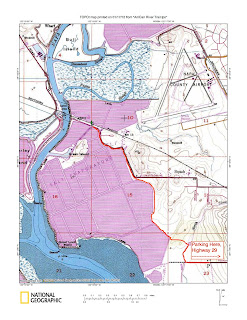In Napa County where I live there is a vision of a bicycle/pedestrian path that will someday allow users to walk or ride virtually the entire distance between the city of Calistoga in the north and American Canyon in the south. That vision is slowly but surely materializing into reality. Already significant stretches of what is referred to as the Napa River Trail have been completed with more pieces in the works, while the Napa Valley Vine Trail begins to take shape having recently received significant grant awards. This past weekend Patrick and I took our bikes and binoculars down to American Canyon to ride the almost 3 miles of the newest portion of the River Trail. The trail runs north from the staging/parking area at the west end of Eucalyptus Drive along the edge of what used to be salt evaporation ponds that had belonged to the Cargill Corp. These ponds were sold back to the State of California and the Dept. of Fish and Game has done an exemplary job of restoration so that now they are tidal mudflats that are supporting more and more birds. Every indication is that the Napa/Sonoma Marsh system is now capable of supporting an increasing number of resident bird species as well as providing critical rest and nourishment to the millions of migrants who have and will continue to rely on it.
As we rode the trail the tide was on it's way out leaving much of the mudflats exposed and teaming with shorebirds. We had Dunlin, Dowitchers, Willits, Least Sandpipers, Western Sandpipers, Black-bellied Plovers, Black-necked Stilts, Avocets and a new county bird for me Semipalmated Plovers. We also had a nice look at a juvenile Peregrine Falcon on a roost near the parking area. I'll be returning soon when I have a bit more time and my scope so I can get some better looks at the plovers. You can access this portion of the river trail off of highway 29 in American Canyon opposite the large Walmart monstrosity. Follow Eucalyptus Drive west over Oat Hill to the parking area at the end.



